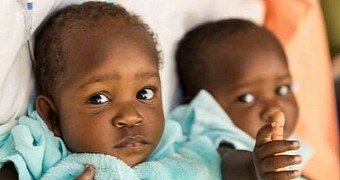Last Thursday, September 3, 11-month-old conjoined twins Acen and Apio Akello underwent surgery at the Nationwide Children's Hospital in Columbus, Ohio, and were successfully separated by a team of more than 30 medical experts.
The intervention took 16 hours to complete. The girls were taken into the operating room at 7:30 a.m. and were in surgery until 11:30 p.m, Medical Express informs.
Young Acen and Apio are now in recovery. They are closely monitored and under treatment, and the doctors looking after them reassure they are both doing just fine. For now, it is unclear how long they will have to remain hospitalized.
The surgery was especially tricky
11-month-old Acen and Apio Akello arrived at the Nationwide Children's Hospital in December 2014, when they were flown in all the way from Uganda together with their mother.
Joined at the pelvic and hip region, the girls had not just entangled muscles and other tissues, but also nerves. To separate them, medical experts had to carefully divide their spinal cords, which were also intertwined.
Before they could divide the spinal cords, the surgical team had to determine which nerves belonged to Acen and which to Apio. The same procedure was followed when separating muscles.
“Because of the delicate job our neurosurgeons had of separating the spinal cord, our team was assisted by neurophysiologic intraoperative monitoring and the technicians were able to tell us which muscles and nerves belonged to Acen and which belonged to Apio.”
“This is the first time this specific type of monitoring has been done in a conjoined twins' separation surgery,” explains Gail Besner, chief of Pediatric Surgery at Nationwide Children's Hospital.
Once all the nerves, muscles and other tissues connecting the two 11-month-old girls were divided, surgeons worked on them individually to make sure they each had a proper digestive tract and that their organs were all in place. Then, their wounds were covered.
The intervention was months in the making
Some time before actually operating on the girls and separating them, doctors placed so-called tissue expanders under their skin and left them there for a few months.
They did so to make sure that, once the girls were separated, they would have enough skin to cover the wounds created when dividing their bodies.
Now that they are no longer conjoined, experts at the Nationwide Children's Hospital expect Acen and Apio Akello will soon enough make a full recovery and go on to enjoy long and healthy lives.

 14 DAY TRIAL //
14 DAY TRIAL //